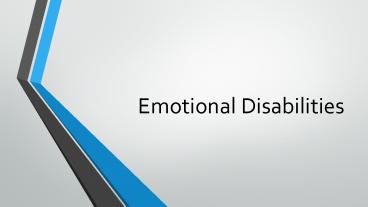Emotional Disabilities - PowerPoint PPT Presentation
1 / 9
Title:
Emotional Disabilities
Description:
Emotional Disabilities What would you do? Tina asks Billy can she borrow a pencil. Billy jumps up from his seat and starts yelling at her about how she needs to bring ... – PowerPoint PPT presentation
Number of Views:212
Avg rating:3.0/5.0
Title: Emotional Disabilities
1
Emotional Disabilities
2
What would you do?
- Tina asks Billy can she borrow a pencil. Billy
jumps up from his seat and starts yelling at her
about how she needs to bring her own pencils to
class. He throws a chair across the room and then
starts wailing crying loudly in he middle of the
floor. - Brainstorm on how you would respond.
3
.
- IDEIA 2004 Definition of Emotional
Disability/Emotional Disturbance - A condition exhibiting one or more of the
following characteristics over a long period of
time and to a marked degree that adversely
affects a childs educational performance - An inability to learn that cannot be explained by
intellectual, sensory, or health factors. - An inability to build or maintain satisfactory
interpersonal relationships with peers and
teachers. - Inappropriate types of behavior or feelings under
normal circumstances. - A general pervasive mood of unhappiness or
depression. - A tendency to develop physical symptoms or fears
associated with personal or school problems. - Emotional disability includes schizophrenia. The
term does not apply to children who are socially
maladjusted, unless it is determined that they
have an emotional disturbance
4
Problems in School A student with emotional
disability will have severe difficulties in
school. A typical student will be able to follow
a teacher's instructions independently, and will
have no problem asking for help if needed. A
child with an emotional disability will have
difficulty carrying out these same
age-appropriate instructions, and may be fearful
of asking for help. This can create an inability
to learn on the same level as other peers of the
same age, which causes the child to view school
as a source of misery and confusion. This often
leads to poor grades and excessive
absences Read more http//www.ehow.com/info_8
611450_signs-symptoms-emotional-disability.html
5
Problems with Others Emotional disability can
have detrimental effects on a child's ability to
make friends and interact with others. A typical
child will be able to approach a group of his
peers, converse, and join in their activities.
The child with emotional disability will be
consistently rejected or ignored by these peers
due to a lack of appropriate social skills, and
may even be taunted or called names. An
emotionally disabled child may be viewed as
immature or "weird" by other children of his age
group. Read more http//www.ehow.com/info_861
1450_signs-symptoms-emotional-disability.html
6
Problems in Behavior An emotionally disabled
child will become socially anxious and withdrawn
in public. When faced with risks or decisions,
however trivial, she will become tense and
fearful. She will have extremely poor
self-esteem, and may seem have a distorted sense
of reality, usually preferring to live in her own
fantasy world. These children will often
internalize their feelings and emotions, and have
difficulty talking about them when asked.
Occasionally they may lash out and hurt others
out of fear and a desire to be left
alone. Read more http//www.ehow.com/info_861
1450_signs-symptoms-emotional-disability.html
7
Problems in Development Emotional disability
often causes children to regress developmentally.
They may behave as though they were much younger,
even to the point of seeming overly dependent on
others. As these children become older, they may
be at risk for substance abuse, although due to
their lack of social ability, they may be less
likely to use drugs in a group context. Read
more http//www.ehow.com/info_8611450_signs-symp
toms-emotional-disability.html
8
(No Transcript)
9
Prevention/Solution Foster children are more
likely to have emotional disabilities because
some of these children come from an abusive home.
One of the major ways of preventing emotional
disabilities is to prevent the abuse from
starting in the first place. Abusive parents need
to seek professional help before they leave life
long scars on their children. Children do need
discipline, but abuse and discipline are two very
different things. The word discipline means to
teach and guide. Children need to know right from
wrong and they need to have limits. Abuse happens
when a child is verbally put down or physically
hurt in some way. Children who are protected from
abuse grow up more mentally and emotionally
stable than children who suffer abuse throughout
their lives. In some instances the emotional
disability cannot be prevented. This happens when
children suffer from a condition such as autism
or bi-polar disorder. Medication may be necessary
in order for the child to live a normal
life Read more http//www.ehow.com/about_4709
966_emotional-disabilities.html































